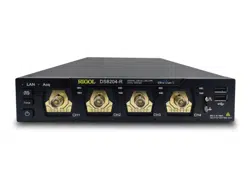Loading ...
Loading ...
Loading ...

RIGOL Chapter 5 To Trigger the Oscilloscope
5-4 DS8000-R User Guide
Trigger Mode
The following is the schematic diagram of the acquisition memory. To easily
understand the trigger event, we classify the acquisition memory into the pre-trigger
buffer and post-trigger buffer.
Figure 5-1 Schematic Diagram of the Acquisition Memory
After the system runs, the oscilloscope operates by first filling the pre-trigger buffer.
It starts searching for a trigger after the pre-trigger buffer is filled. While searching
for the trigger, the data sampled will still be transmitted to the pre-trigger buffer (the
new data will continuously overwrite the previous data). When a trigger is found, the
pre-trigger buffer contains the data acquired just before the trigger. Then, the
oscilloscope will fill the post-trigger buffer and display the data in the acquisition
memory.
DS8000-R provides three trigger modes: Auto, Normal, and Single. The default is
Auto.
The trigger mode is displayed at the upper-right corner of the screen: A (Auto), N
(Normal), and S (Single).
⚫ Auto: In this trigger mode, if the specified trigger conditions are not found,
triggers are forced and acquisitions are made so as to display the waveforms.
This trigger mode should be used when the signal level is unknown or the DC
should be displayed as well as when forcible trigger is not necessary as the
trigger condition always occurs.
⚫ Normal: In this trigger mode, triggers and acquisitions only occur when the
specified trigger conditions are found. This trigger mode should be used when
the signal is with low repetition rate or only the event specified by the trigger
setting needs to be sampled as well as when auto trigger should be prevented to
acquire stable display.
⚫ Single: In this trigger mode, the oscilloscope performs a single trigger and
acquisition when the specified trigger conditions are found, and then stops. This
trigger mode should be used when you need to perform a single acquisition of
the specified event and analyze the acquisition result (you can pan and zoom
the currently displayed waveform, and the subsequent waveform data will not
overwrite the current waveform). After a single trigger mode is initiated, the
operating status of the oscilloscope is in "STOP" state.
Pre-trigger Buffer
Post-trigger Buffer
Trigger Event
Acquisition Memory
Loading ...
Loading ...
Loading ...
